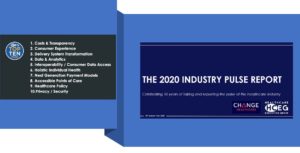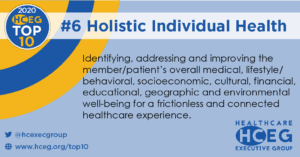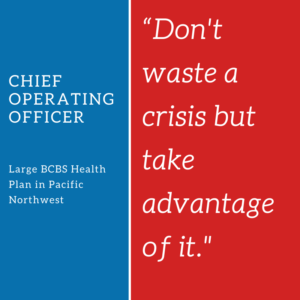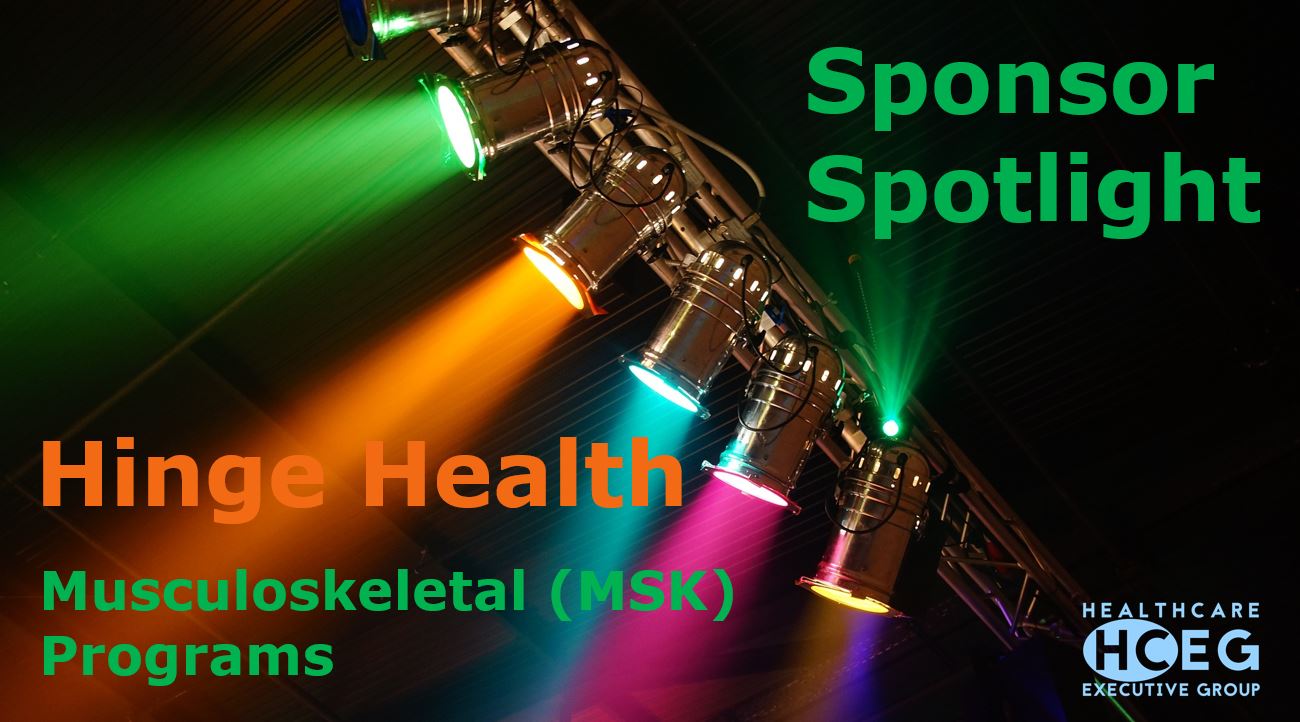The Collective Voice in Health IT is a new podcast series launched by our partner WEDI – the Workgroup for Electronic Data Interchange. The intent of this new podcast series is to offer engaging and intimate discussions with prominent healthcare thought leaders on both current and emerging themes and topics in healthcare: market trends, information technology, and regulations and policies. These important topics are examined from many different angles including the intersection of strategy, operations, marketing, big data, and clinical programs – among other important areas and viewpoints.
In the inaugural episode, Matthew Albright, Communication Committee Chair for WEDI and Chief Legislative Affairs Officer for Zelis Payments and Ferris Taylor, HCEG’s Executive Director, discuss how challenges, issues, and opportunities identified by the 2020 HCEG Top 10 list have exposed inequities and inadequacies in our healthcare system. Matt and Ferris explore priorities top of mind less than six months ago; where those priorities were then and where they are now. To wit, they compare topics ‘Before Coronavirus’ (BC) to where they stand now.
Also included is a discussion about the 2020 Industry Pulse and the recently completed COVID-19 Flash Update survey measuring how priorities identified when the 2020 Industry Pulse was released in February of this year to where healthcare leaders and change-makers think those priorities lie now. 
Subscribe to the HCEG eNewsletter here.
Connect, Collaborate & Create – The Collective Voice in Health IT
Matt Albright asked Ferris Taylor: How do we deal with the costs of specialty pharmaceuticals and continue going forward with respect to vaccines and testing and everything else is coming with COVID-19? But even more importantly, right behind that fundamental change of Costs & Transparency was: What’s happening with the consumer and the consumer experience?
Ferris responded:
“The transition (to the healthcare consumer and the consumer experience) has been slow to develop in healthcare. It was gaining more understanding from both the payers and the providers and all the stakeholders in healthcare of what it really means to be consumer-centric. We know what that means with Amazon or what it means with Alexa, but healthcare was far away from that in terms of consumer centricity and, of course, delivery system transformation, which could include how we make this transition from fee-for-service to value-based reimbursement.
But prior to the coronavirus pandemic, it (the transformation of healthcare) was already deep into digital health and personalized medicine, and holistic healthcare at the personal level.
Now obviously things have changed in the last few months. We couldn’t be more positive that the consumer healthcare experience in the last few months has been less than par. And, of course, one of the biggest and more obvious changes in healthcare has been around the HCEG Top 10 item labeled as Accessible Points of Care. Telehealth has exploded, driven by the absolute necessity for consumers to shelter in place. But the fact they (consumers) still needed access to care and also by providers recognizing that it wasn’t desirable to have patients come into their offices. So that blip in the concerns and issues that were being addressed in coronavirus has certainly impacted the Top 10. And we’ll see statistically how that has changed with the COVID flash survey that we’re just completing right now during the end of July.”
Social Determinants of Health – Aka. Barriers to Entry
Ferris shared his insight on how the coronavirus pandemic has drawn focus to the impact of social determinants of health and the importance of addressing the ‘barriers to health care.”
“I guess the other change, a couple of changes, are to Healthcare Policy, number nine on the HCEG Top 10 for 2020, most certainly has moved up. It seems like regulations change every day. And I’m seeing more discussion around Population Health that has been there (on the HCEG Top 10) for many years. It was starting to get described in the term that we most commonly use: Social Determinants of Health. I personally prefer Barriers to Health but for some reason healthcare has historically and narrowly defined healthcare as medical intervention and has excluded the barriers to health. COVID-19 has certainly challenged that thinking and changed the way that we are thinking about healthcare.”
Matt added:
“I think what’s interesting is when you talk about the priorities coming into 2020 absolutely things have changed. Absolutely its flipped – everything’s been flipped on its head. But the issues themselves or, if you will, the categories of issues haven’t changed, right?
So you talk about Digital Health which we see expressed through Telehealth. You talk about Consumer-Based or Consumer-Centric healthcare. And you talk about how, in the last six months, we’ve seen how that’s kind of failed on a certain level. And certainly, Social Determinants of Health has played itself out in the inequities in the races and the genders and the status of the people who have been ended up hospitalized and actually dying of this disease.
So actually, it seems to me in 2019 the priorities and what came out of your Top 10 had it right? It’s just that now it’s been put under a pressure test. All of those issues have kind of sped up. And the other thing, which I think is interesting and maybe it’s tied somehow to how it’s affected consumer-based health, is that everybody’s talking about it. Right?
I had no idea that at the beginning of this year that I would know so much about viruses and how they were spread and so much about how vaccines were pursued.”
 Healthcare Reform – Needs a Grass Roots Movement?
Healthcare Reform – Needs a Grass Roots Movement?
[31:09 – 32:40]
Matt Albright: “I think healthcare has suddenly become a dining room table conversation, a backyard barbecue topic – with social distancing, of course. A conversation where people are talking about the priorities of their group or a group in a specific industry – and looking to their own industry. Suddenly, this industry (healthcare) is everybody’s concern and suddenly every aspect of what you just talked about: telehealth, digital health, inequalities, all of those issues are suddenly being discussed by the people.
Matt queried Ferris with two questions about the ongoing pace and longevity of processes and approaches wrought by the pandemic.
- Do you think that, because everybody’s talking about it, there will be a grassroots push to see these things sped up? Virtual health, telehealth, the exchange, data interchange, interoperability of health IT, and transparency issues. Or do you think we’re going to be so exhausted as a healthcare industry after this pandemic, especially at the provider and hospital levels, are kind of economically bereft that we won’t be able to move forward very fast?
- How do you think the last six months adds to what’s going to happen next once we conquer this thing?
Never Let a Good Crisis Go to Waste
[32:50-34:40]
Ferris shared how the coronavirus crisis has accelerated the transformation of the healthcare system:
“One of our board members, a past COO at a large payer in the Pacific Northwest, said: ‘Don’t waste a crisis but take advantage of it.’ And in some ways, that old and trite saying that: ‘necessity is the mother of invention’ – is really coming into play here. Healthcare was already moving from analog to digital. We can come back to fax machines at some other point.”
Inequities & Inadequacies Exposed
[35:30 – 37:38]
“The COVID crisis has exposed a lot of inequities and inadequacies in our healthcare system. Lack of preparation. Safety concerns. We were disregarding a lot of public health issues that are now very much top of mind. And underneath all of that is as I listen to our members and the discussions back and forth, going back to this 2019 HCEG Top 10 priority number one Data & Analytics, it’s now moved to much more of a foundational function across Costs & Transparency, Consumerism, and Digital Transformation.
At the heart of these priorities are the challenges have also been exposed around electronic data aggregation, how we exchange data, how we get the right data at the right time about the right person in the hands of the right decision-maker in a near real-time environment to function as a healthcare system. And so platforms, technology infrastructure, interoperability, as you mentioned, have become significantly more important in terms of supporting healthcare and moving us from a transactional type of consumer experience to a much more continuous interactive, personalized, holistic consumer experience in health.”
“There isn’t a single person in the United States that is not much more cognizant of their personal health, how they feel, and how they’re protecting their health today than they were six months ago. It’s a different world.” – Ferris Taylor
 When Will Consumer-Driven Healthcare Take Hold?
When Will Consumer-Driven Healthcare Take Hold?
[42:47 – 44:48]
Matt Albright shared:
“And you know, I’m an impatient American. So my next question to you is going to be: When? I think we’ve legislatively done things out of emergency and some of the states and certainly CMS is kind of pushing to keep certainly some of the waivers that are in telehealth to keep them permanent. So we’re starting to see that already but on the same token the interoperability rule enforcement has been delayed because the hospitals just don’t have the bandwidth to make that lift right now. And the transparency rules are being argued in court.
So I guess, I don’t think we have the question here, but when are we going to see this consumer-driven healthcare take place? And when are we going to see, McKinsey says 20% of our healthcare visits will be virtual – our healthcare payouts – be in just a year or two? When do you think we’re going to see that? Is that going to have to wait for Congress to have lots of discussions about it and three or four years later we have regulations? What do you think?
Ferris responded:
“Well, and you know, there’s an interesting connection between Congress and the healthcare consumer. And that is, Congress exists because of voters. And voters are consumers of healthcare and consumers have experienced a very different healthcare environment in the last six months than they had experienced over the last number of years or even decades.
So part of the answer around when (consumer-driven health becomes widespread) shows up in the emergency orders, the state initiatives, governors’ responses, and even at the federal level some of the initiatives and emergency orders that President Trump and others, agencies have issued and put out there.”
RELATED: Surviving Coronavirus Pandemic & Thriving on the Other Side: Rapid Innovation & Telehealth
Healthcare System Survival Mode – Uncertain Recovery Timeline
[44:49 – 46:57]
Ferris shared an analogy and his take on when the healthcare system may recover.
“Obviously, along with when is how, how do we finance it? And how do all of those pieces come together? Right today, it’s hard right today to give a specific answer to your question. I kind of feel, I don’t know about you, but I feel hunkered down in the foxhole in the middle of a war with bullets flying. Flying over my head. I’m sheltering in place. I haven’t been on a plane since I think the last time I saw you in Jacksonville. And that was my last trip and I had a whole bunch of them planned but life has changed. But when you’re in that foxhole, it’s not the time to stand up and get up on a Podium and say let’s do this. Let’s do that.
I think we’re in a survival mode right now in healthcare. We’re still dealing with a surge. But as we start to flatten the curve and as we get back into the Healthcare System, the benefit designs to deal with a pandemic like COVID and the incorporation (of new services) into those designs and into the pricing for 2021. Or it might even be that it takes 2022 to get all of the financial part of this back in place so we have a stable healthcare system.
I have no doubt that we will get back to this new reality of consumerism, transparency, interoperability and the incorporation of 21st Century Technologies: artificial intelligence, machine learning, interoperability and real-time data exchange.”
Inveterate (Chronic) Innovation – Table Stakes for Survival
[47:03 -47:27]
“So, I think the answer to your question is: this too will pass, and we will get through COVID-19. I don’t know exactly when that will be. But on the other side in my 30 years in healthcare, I continue to just be very impressed with the inveterate innovation that has come into healthcare.
[49:27 – 51:41]
Innovation is here to stay. It’ll have to get priced out. It will have to get built into the financial models that make healthcare work. Hospitals, some hospitals are doing fine financially. Some, especially rural hospitals, are under extreme pressure. Different specialties in healthcare are experiencing different results. Health plans are concerned about all of the delayed, non-essential healthcare comes back. Is that going to hit them financially and with premium increases?
We’re a very state of the art, world-renowned healthcare industry and we’ll figure this out. I think that stability on the other side of the bridge will be consumer-centric. It’ll be transparent – whether it’s from costs or delivery processes or anything else. The delivery system will be much more virtual and if you push me, I’m going to say some time in 2021 – for sure 2022 – we’ll be back on track.”
Matt Albright added:
“Good. Ferris, I think you bring a great perspective. There’s no longer looking forward to Innovation. Innovation has already happened and we’re not calling it innovation anymore. We’re calling what we do on a day-to-day basis now with healthcare as innovation. I think that’s a terrific point. And I think there’s a lot to be said for how quickly our healthcare system reacted and proactively moved to take care of this pandemic.
And frankly, I’d probably have to say the same for our political systems. They came out very quickly. The governors came out very quickly with emergency orders that freed the providers to do what they needed to do. And even Congress, there’s a criticism to be had there, but they turned things around very quickly to get things moving. So, I think that’s a great point, things are already happening. Things are already here. Maybe there’s nothing that we need to wait for?”
2020 Industry Pulse Flash Update
[51:42 – 52:28]
Matt concluded the inaugural episode of The Collective Voice in Health IT podcast series with a question as to when the results and analysis of the COVID-19 Industry Pulse Flash Update survey will be available.
Ferris shared:
“I looked at the initial results of the flash survey on Tuesday, so just two days ago. We’ll have something ready to publish in two to three weeks. And I think Michael (McNutt – WEDI Director of Education & Events) and Charles (Stellar – WEDI CEO) and you and I have talked about coming back here in August with a WEDI-specific webinar. We can have questions coming in and be able to respond to those in an interactive way. So three to four weeks and we’ll be back on the air. Thank you, Matt, Michael, and Charles, for a great discussion.”
RELATED: Connecting the Dots: COVID-19, HCEG Top 10, & Industry Pulse
Connect, Collaborate & Create Solutions – The Collective Voice in Health IT
Matt closed the initial episode of The Collective Voice in Health IT with a call for the health information technology community to connect, collaborate, and create solutions for a Better Health System. If you’d like to participate in identifying, creating, and sharing information, ideas, and opinions on areas of interest to healthcare leaders and change-makers, reach out to us here.
Subscribe to the HCEG Newsletter here.


 Healthcare Reform – Needs a Grass Roots Movement?
Healthcare Reform – Needs a Grass Roots Movement?
 When Will Consumer-Driven Healthcare Take Hold?
When Will Consumer-Driven Healthcare Take Hold?




